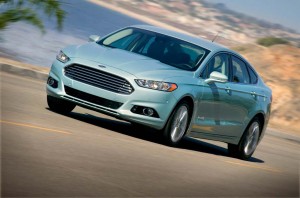
With Ford's Green Zone technology, this hybrid Fusion could run alternately on its battery or its internal combustion engine without any driver input to meet the requirements of the area the car is traveling.
As the Ford plug-in hybrid travels down Village Road, a short distance from the maker’s corporate headquarters, the driver notices a subtle shudder from under the hood. A quick glance down at the instrument panel reveals that the car’s four-cylinder gas engine has shut off, leaving the sedan to run solely on battery power.
A few miles later, the process reverses itself, the car’s engine automatically firing up again as it exits out of an area marked in green on the Fusion’s video navigation screen.
Though still in the development stage, Ford’s Green Zone system promises to improve the energy efficiency of its battery-based vehicles. It could also help motorists avoid tolls and penalties as a growing number of cities enact restrictions on driving conventionally powered automobiles in inner cities, such as London. The technology also could be used, Ford researchers say, to improve the functionality of other vehicle functions, including headlights and transmissions.
“We’re looking at ways to make driving more efficient, intelligent and safer,” explains Joel Brush, a global account director with Here, a subsidiary of technology giant Nokia, which is providing the underlying mapping information for the Ford Green Zone system.
Ford offers several battery-electric vehicles, including plug-in hybrids like the Fusion. When fully charged, the sedan normally will start out in electric-only mode, then switch on its gas engine when the batteries are depleted. But that isn’t necessarily the most efficient way of doing things, notes Jason Meyer, the Ford programmer for the Green Zone project.
Batteries are more effective when operating at slower speeds, especially in stop-and-go driving, rather than at highway speeds. Meanwhile, an owner might choose to reserve the batteries for driving in specific areas towards the end of a commute, rather than right out of the driveway.
And that could become more common as a growing number of cities consider ways to incentivize the use of zero-emissions propulsion. In London, for example, motorists running on battery power are exempted from the costly inner city commuter fee.
In its preliminary form, a motorist would go to a website – or use the navi screen – to set up specific zones, displayed in green, where the vehicle would automatically opt to run on battery power if possible. The motorist would no longer have to remember to switch back and forth manually.
The system would go a step further, factoring in such things as traffic congestion, and even the grade of the roadway itself, to determine when to most efficiently use battery or gas power – or both. Programmers also hope to allow the system to respond to driver behavior. It could recognize which member of a family is behind the wheel, for example, and adjust automatically if the current driver is more aggressive with the throttle.
“We want to create a system that is as flexible as possible to meet the needs of as many customers as possible,” explains Meyer, riding along in the passenger seat.
(Ford plans to take on Toyota Prius with new hybrid line. For more, Click Here.)
The Green Zone technology would have significant potential in a plug-in hybrid, but Ford is betting it could offer advantages even in a conventional vehicle. Nokia’s mapping data is so precise – parsing the roadway down to a few centimeters in detail, notes Brush, that it could know when a car is entering a corner or approaching a hill. That information could be used to shift where headlights are pointing, or to change gears for maximum mileage.
(Click Here for details on how death-free highways are a possibility.)
In fact, several manufacturers, including Mercedes-Benz with its new S-Class sedan, have begun using map data in Europe to improve transmission efficiency.
(To see if Cadillac is considering moving some of its operations out of Detroit, Click Here.)
Ford programmers still have a number of challenges ahead. They have to figure out how to handle situations such as a winding road that might cut in and out of a green zone, for example. And with the federal government moving ahead with plans to create a vehicle-to-vehicle communications network, the Green Zone system might eventually incorporate that data into its decision-making process.
“We’re still a few years away” from production, says Meyer, but Ford is confident it will eventually offer Green Zone technology in at least some of its products.

Blah, blah, blah. Big talk with nothing to show for it.
They should spend the same amount of effort fixing the disaster known as Lincoln and less talk about clueless ideas.